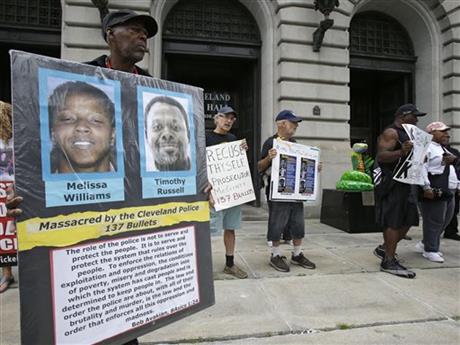
By THOMAS J. SHEERAN
In this Tuesday, Aug. 13, 2013 photo shows Cleveland residents holding up signs in protest of the Cleveland Police Department in Cleveland. Months of disciplinary hearings and racially charged complaints against police has set the scene for outside investigations focused in part on a chase that killed two apparently unarmed people. The chase and riveting video came amid a growing list of complaints about police handling of missing person cases and rape investigations. The escape to freedom of three women held captive over a decade resulted from one victim kicking out a door, not police work. (AP Photo/Tony Dejak)
CLEVELAND (AP) — It hasn’t been a good year for the Cleveland Police Department.
A county prosecutor is investigating a deadly chase in November that involved more than 60 squad cars and ended with 137 shots fired by 13 officers at two unarmed black people. The U.S. Department of Justice is reviewing years of excessive force claims.
And a growing list of complaints about the handling of missing person cases and rape investigations culminated with the escape of three women who had been held captive and raped for more than a decade. They were freed not because police cracked the case, but because one victim kicked out a door and yelled to neighbors for help.
The turmoil has hurt police morale, invigorated a mayoral campaign and led to frank discussions about the divide between the majority black residents of one of the nation’s poorest cities and a police department critics say is too quick to use force in some cases and lackadaisical in other respects.
The cases have harmed the police department’s standing in the eyes of residents, mayoral spokeswoman Maureen Harper said in a recent video presentation in Columbus on handling public information issues.
“Overall, quite frankly,” she said, “our image was not good.”
Discontent with the police department has led to protests against the administration — including one featuring several dozen people chanting inside city hall and another outside the courts building — and angry letters to the editor. One compared the wild chase to a Bonnie and Clyde getaway.
The chase, with more than a third of on-duty officers participating, began when one officer thought he heard a gunshot from a car speeding by police headquarters. It ended in a blocked-off parking lot, with driver Timothy Russell shot 23 times and passenger Malissa Williams shot 24 times.
Both victims were black, and no weapon was found. In a well-integrated police force, the makeup of the officers who fired raised the issue of race — 12 are white and one is Hispanic.
Any wrongdoing during the chase resulted from the failure of officers to comply with departmental rules, Mayor Frank Jackson and Police Chief Michael McGrath said, while the state attorney general criticized a “systemic failure” of communication and command.
Disciplinary hearings were held for more than 100 officers accused of joining the chase without permission, failure to manage officers or other departmental violations. A sergeant who was fired is appealing the dismissal.
The situation is creating a lasting effect on rank-and-file morale, said Lt. Brian Betley, head of a police supervisor union challenging disciplinary actions including a dismissal.
“I’d be a liar if I said that it didn’t affect it in some way,” he said. “I’m sure it’s on everyone’s minds.”
Jeff Follmer, president of the police union, said the officers acted properly because the fleeing driver had tried to ram them.
But James Roberts, 61, who works as a debt collector in the city, doesn’t buy it.
“It was totally uncalled for. It was excessive,” Roberts said, noting that police also have a poor reputation for shoddy investigations of missing person cases over the years. He suggested police hold town hall meetings to hear residents’ concerns and rebuild relationships.
Police have faced questions over their response to missing person cases before. In 2009, Anthony Sowell was charged with killing 11 black women on Cleveland’s east side and hiding their bodies around his house and yard. He was found guilty and sentenced to death.
Kidnapper Ariel Castro was sentenced this year to more than 1,000 years in prison for kidnapping three women and holding them in his dilapidated Cleveland house for a decade; he committed suicide in his cell last month.
Both cases raised questions about how vigorously police investigated missing person cases, especially Sowell’s inner-city black victims, some of whom were living on the street and had drug problems.
In recent months, the Justice Department has investigated excessive force claims in Albuquerque, N.M., Miami, and Los Angeles County. In Cleveland, the government said the investigation would expand beyond the fatal chase to include policies and training.
Chief McGrath told The Associated Press during the Columbus appearance that it’s tough for him to say where the public’s perception of his department stands now, but he said, “We’re moving in the right direction.”
Police have reached out in neighborhood meetings, including “coffee with a cop” sessions that include City Council members — often the first to hear citizen complaints against police.
Still, the troubles have been a distraction for Jackson, a black Democrat seeking a third term in November against businessman Ken Lanci, who has campaigned on a promise to dismiss the chief if elected.
Jackson, whose staff rejected recent interview requests, told television interviewers as the disciplinary hearings began in late spring that he supported McGrath.
“This white police chief is the only person that has given any semblance to justice and fairness in this whole process,” Jackson said.
Donna Walker-Brown, 44, an activist involved with an inner-city anti-crime group, faulted Jackson’s leadership.
“Even though the mayor is black,” she said, “right now he is not when it comes to the black community.”
___
Associated Press writer Kantele Franko in Columbus contributed to this report.



